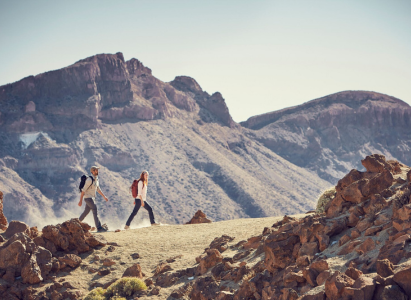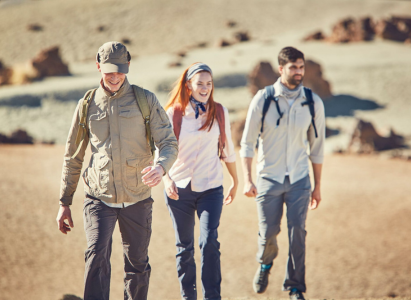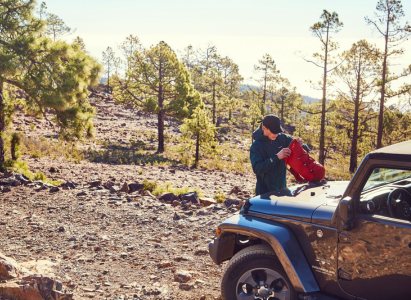
What to Pack For a Hike
Are you planning on going hiking? It’s time to breathe in the fresh country air and feel the absence of flagstones and pavement underfoot; but being unprepared when hiking can really dampen spirits - not one of us likes to be caught out in the rain without their waterproof jacket or stuck walking miles with wet socks. To make sure you have the most enjoyable short or full day hike, we’ve prepared a list of the equipment you’ll need to pack and take along with you – some essential, some optional.
And so, in this guide, you’ll find a comprehensive list of what to pack for a hike along with some tips and advice on why. Bear in mind, every hike is different so we’d invite you to keep an open mind and think on what, within this list, is suitable for your hike.
Hiking Check List
What do you need to bring to a hike? There’s a long list of options depending on how long the hike is, how many days the hike is, what season, where you’re going etc. What we’re going to include in our list is aimed at those shorter hikes; 12-hour hikes or less. For these shorter hikes we’ve provided a hiking checklist for you:

- Rucksack/Backpack - The size will vary depending on your hike length. For a short hike, a backpack should suffice.
- Waterproof Jacket & Trousers - Don’t be fooled by the forecast, especially if you’re heading somewhere remote where the weather can change just like that. Over Trousers are an excellent choice if there’s only a risk of rain.
- Footwear - Waterproof, a good fit, comfortable. Footwear is one of the most important pieces of gear for a hike.
- Hat, gloves, scarf - These are essential any time of year, especially if you’re heading to mountains or hills.
- Walking Poles – Walking poles are great for hilly/mountainous environments. But otherwise not necessary.
- Torch/Headlamp – You’ll only need this for winter or late evening hikes, though I’d recommend you bring one regardless.
- Spare clothes - These can be extra layers in cold conditions, or a lifesaver if you're caught in the rain.
- Spare socks - We all know the unpleasantness of having wet socks. Which is magnified by having to walk in them for miles. Spare socks are a necessity.
- Power Bank – This is particularly useful if you use a GPS tool like google maps as these drain your mobiles power rapidly.
- Map & Compass - Make sure to plan your route before heading out. Take an up-to-date map of where you’re going and observe each fork in the road to determine the right path.
- Food - Pack enough food for your usual meals plus a hearty snack in between each to increase your calorie intake.
- Water - Don’t let yourself get dehydrated. Your body loses a lot of water on a hike, so be sure to replenish the loss.
- First Aid – Bandages, scissors, blister plasters, pain killers, anti-inflammatory, anti-allergies.
You may also want to take a camera or sun cream depending on conditions and environment
How to Pack a Hiking Bag
Now you know what to take with you, it’s time to move it all into your trusty backpack. Wondering how to pack a hiking bag in the most efficient way possible? There’s an art to maximising space and minimising time spent rummaging around for hard to reach accessories.
Follow these simple steps for packing a rucksack on a trek.
- Line the inside of your rucksack with a dry bag for waterproof protection.
- Start with packing the items you think you’re least likely to need. Put your spare clothes at the bottom of your bag – you shouldn’t need them, but they’re good for emergencies.
- On top of your spare clothes, put in anything that you are likely to need, but don’t need super-fast access to. This includes your snacks, optional accessories like your camera and first aid kit, warm layers (including hat, gloves and scarf).
- At the top of your bag you’ll want anything you need quick access to. Your waterproofs should be on top – if the weather takes a nasty turn its best to be prepared for quick protection.
- If your rucksack has exterior pockets, use these for smaller accessories, such as your maps, sun cream any non-valuable personal items. Also, side pockets are a great place to keep your water bottles for easy access.

Top tip: a dry bag in your rucksack will not only protect your belongings from the rain but can also be a lifesaver if your bag falls into water. Make sure you pack your dry bag with all the belongings you need to protect, and your hiking essentials will stay dry, keeping you warm when the weather takes a turn. Check out our outdoor accessories range for hardy dry bags, rucksacks and more.
Tips For Packing A Backpack
If you think about packing a rucksack from the bottom up, you’ll be in great shape.
- Roll your spare clothes: it’s amazing how much space spare clothes can take up, so any way you can minimise this is a bonus.
- Don’t waste space: don’t get weighed down with unnecessary accessories – only take them if you’ll use them!
- Pack in the same way: once you get the knack for packing, don’t change it up, or you risk not being able to find what you’re looking for.
And there you have it – our advice on how to pack a rucksack successfully. By only taking the essentials, and smartly packing them into your rucksack, keeping quick access accessories towards the top, you can save yourself from awkward accessories getting in your way. Just make sure you have all the hiking gear you need before your trip.
Happy hiking!